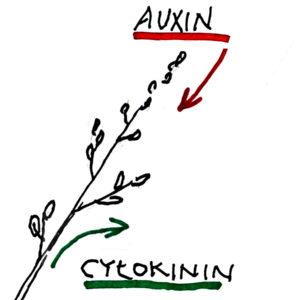Amethyst Spray
By Dennis Klocek 5 min read
In the summer of 1993 an experiment was undertaken to see if the potentization of the gem amethyst would have an effect upon plant growth in the climatic niche of the central valley of California.
The goal was to see if a variation of the 501 spray could be made which would provide a more moist light under the arid intense light conditions of a central California summer.
The crop chosen was cabbage. It was sown in May, a usually foolhardy proposition in that the growing temperatures often are in the 100s or high 90s from early July until mid-October: that is, during the cabbage maturation period. Normal early cabbage sowings are done in mid-July and the plants persevere in the heat until the cooler fall temperatures provide the dew and coolness that they require.
The amethyst was chosen because of its cool shadowy violet color. It is a gemstone in the silicate family, which has an interesting chemical profile that suggested that it would be a good spray for plants, especially cabbages. The chemical/mineral constituents of amethyst are 1. Silica, 2. Lime, 3. Soda. The metals are 1. Iron peroxide, and 2. Manganese. Silica is present in preparation 501 as the carrier of light forces into the plant. In like manner, amethyst is a silicate. It differs from rock crystal in having a calcium radiation in its chemistry. This calcium radiation is a primary need of cabbages in order to support their large leaf formation gesture. In amethyst, the silica is united to calcium. The amethyst also has iron peroxide in its structure. Iron, especially in the form of a peroxide, has an especially strong relationship to the element oxygen or 'life' in Rudolf Steiner's alchemy found in the Agriculture Course.
Currently, in the ‘fringe’ literature, there are a number of peroxide 'cures' and soil treatments for plants and animals. The basic idea behind using peroxide as a soil drench or animal food is to increase the ability of oxygen to become available to organisms in order to improve their respiration. In the amethyst this extra oxygen is wedded to iron, the breathing metal.
Plants like cabbages, which make heavy demands on calcium in the soil, often make equally heavy potassium demands for mid-ribs of leaves and strong root-stem development. Soda or sodium acts in such a way that it helps to change potassium from an insoluble form to a soluble form in the soil. As a mineral catalyst then, amethyst is a silicate with a calcium/potassium gesture in its chemistry. The metals, iron peroxide and manganese, both show an affinity for enhancing life or vitality, one of the old uses for amethyst jewelry.
The manganese, which is the actual source of the deep violet hue of the gem, has the added property of being particularly suited for relating the sulphuric and the oxidizing forces in metallurgy. According to Walther Kloos in The Living Earth, manganese in nature is always found in combination with oxygen and represents a gesture among metals which indicates support for the vegetative process.
By contrast, metals that have an affinity for sulfur, show affinities for the general (peripheral) life forces of flower/fruit and seed. This again puts the amethyst into close relationship to the life gesture of the cabbage, which is to produce leaf after vegetative leaf before it rises on its stalk into flowering.
By simply comparing the growth gesture between quartz crystal and amethyst, this contrast can be observed. The quartz breaks out into open stamen-like shafts of light as it grows, indicative of a strong seed/light force. By contrast, the amethyst is most often found in geodes pointing inwards towards a center. Its crystals, while they show beautiful points, rarely grow into discrete shafts but instead cluster together in planes of points without shooting into space. This is an analog for the ideal cabbage gesture, a holding of form in one plane before shooting up vertically.
From this it can be seen why the amethyst appeared to be a good cabbage spray candidate.
The experiment sought to retain and possibly amplify these qualities in the grinding process used to render the substance into gem flour. Three nice amethyst points were pulverized and ground between glass plates and then worked in a mortar and pestle for one hour. A very fine, colorless meal resulted. One tablespoon of this was saved and to this as a diluent, 10 tablespoons of orthoclase feldspar were added. The orthoclase is a potassium silicate with traces of calcium. This was used to enhance the potash/calcium action of the spray. This was triturated in a mortar and pestle for one hour.
One tablespoon of this was taken and 10 tablespoons of flint were added as a diluent and one more hour of trituration brought the amethyst to a 3x potentization.
This meal was put into a cowhorn and buried for the summer. Before burial, some of the 3x flour was taken to spray on the cabbage crop. This amethyst spray was applied after 20 minutes stirring in rainwater on leaf days.
Due to the extreme dryness, the seedling cabbages were often sprayed in the evening. In the morning strong dew would always be present in the cabbage patch. The cabbages were mulched heavily and watered by drip system under the mulch. They were side-dressed with a liquid ferment of alfalfa/kelp/and rotted cabbages which had stabilized completely before application to the soil around the plants.
The cabbages grew steadily through a very hot (high 90s/low 100s) summer without missing a beat. They produced enormous heads by September 1st. The savoy heads were sweet, crisp and well filled out. The only blemish was that in some of them the sun had scalded some leaves when the head was forming and those ended up in the cabbage. An overhead shade cloth would have corrected this flaw. The sweetness and perfection of growth belied their hot arid growing period. When they were cut open, the open savoy spaces were filled with shining beads of water, even though no water had touched the leaves or heads during the whole growing period except for dew-fall.
Amethyst sprayings were alternated with barrel compost in the spraying cycles. Ferments were applied during the waxing phases of the moon until head formation was well under way.
No doubt, clay loam with a good heart, heavy mulching and drip irrigation were positive factors in the growth of the cabbages. However, the extreme climatic conditions that they endured prompted very experienced local gardeners to label the idea ‘doubtful.’ However, the size, sweetness, and perfection of a bed full of savoy salad cabbages in early October in our part of California pointed to some unusual gardening techniques.
Next spring the first ‘horn amethyst’ will be used on an over-wintering savoy crop which is now sleeping in the rain, and next summer, horn amethyst will once again be called on to produce positive results from a doubtful experiment.

Dennis Klocek
Dennis Klocek, MFA, is co-founder of the Coros Institute, an internationally renowned lecturer, and teacher. He is the author of nine books, including the newly released Colors of the Soul; Esoteric Physiology and also Sacred Agriculture: The Alchemy of Biodynamics. He regularly shares his alchemical, spiritual, and scientific insights at soilsoulandspirit.com.
Similar Writings
Rhythmical Pruning and Spraying to Enhance Medicinal and Culinary Properties
In the growth of medicinal and culinary plants the balance between two fundamental hormonal influences is a valuable key to enhancing both medicinal properties as well as aromatics and flavour in culinary plants. Most plants are apically dominant. That means that the terminal buds on each branch determine the branching and shooting form of the…
Video: Seedling to Table – Growing Cabbage, Making Kraut
Learn the tricks and tips from Dennis Klocek, master gardener, for how to grow, harvest, and process cabbage into sauerkraut.
